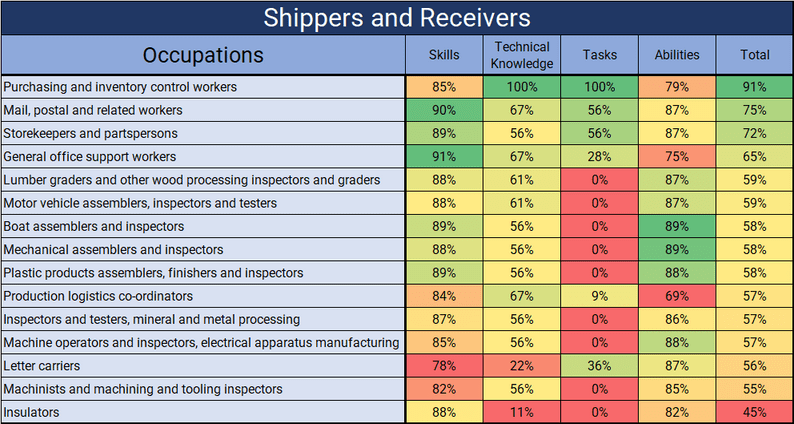Skills Transferability Matrix: Shippers and Receivers
Shippers and Receivers navigate the fast-paced environment of logistical work in various sectors.
They are equipped with skills that allow them to succeed in environments requiring coordination of activities and strict time management, which gives them an edge in roles where quick processing of information is an asset, such as administrative and logistical work. With physical elements required in their work, shippers and handlers possess the dexterity and other abilities necessary to perform work in manufacturing roles and environments.
Skills
Skills are developed through training and experience, and are the practical proficiencies someone possesses. The following are top key skills shippers and receivers employ in their work:
- Time Management
- Critical Thinking
- Monitoring
- Active Listening
- Coordination
Technical Knowledge
Technical Knowledge is the understanding of theory and utility of modern tools in a work environment. The following tools are
used by shippers and receivers regularly:
- Label making software
- Materials requirements planning logistics and supply chain software
- Optical character reader or scanning software
- Word processing software
- Procurement software
Tasks
Tasks are the assigned duties that an occupational group performs in their daily work. The following are the tasks shippers and receivers most regularly encounter:
- Inspect shipments to ensure correct order fulfillment.
- Package objects for shipping.
- Prepare documentation for contracts, transactions, or regulatory compliance.
- Store items.
- Analyze shipping information to make routing decisions.
Abilities
Abilities refer to the innate faculties that allow workers to carry out tasks and activities. The following are the top abilities that shippers and receivers possess:
- Information Ordering
- Inductive and Deductive Reasoning
- Problem Sensitivity
- Perceptual Speed
- Oral and Written Comprehension and Expression
Skills Transferability Matrix
FOCAL’s Skills Transferability Matrices analyze the transferability of an occupation across a multitude of other occupations on the basis of similarities in skills, technical knowledge, tasks, and abilities as outlined by the O*Net database. It aims to show workers how to leverage their skill set in changing occupations, planning a career path, and transitioning to other industries. It also assists policy makers and educators address changing skill sets and areas of opportunity for workforce entrants in developing industries. Employers can also use this tool in reskilling or upskilling workers to circumvent skills shortages, and reduce the hiring and training challenges

After scanning over 2,600 skills, technical competencies, tasks, and abilities of each of the 500 occupations as defined by the National Occupational Classification (NOC) system, a skills transferability matrix for shippers and receivers is produced. In the matrix above, a high score is highlighted in green and indicates the high transferability potential of an attribute of an occupation with that of shippers and receivers. Lower or no transferability areas are marked in red. Shippers and receivers share a very high transferability to purchasing and inventory control workers, indicating that transferring into specialist logistical and supply chain work is possible. Further upward movement from there to a profession they already share some transferability with, production logistics coordinators may be easier. Shippers and Receivers share high transferability with roles in postal and retail services, which indicate that skills relevant to
administration and customer service may be applicable outside logistical work. Shippers and Receivers have low transferability to manufacturing and production roles, indicating that further training and education is necessary to find success in those roles.
To learn more about developments, trends and new technologies in Canada’s automotive manufacturing industry, visit our website futureautolabourforce.ca. You can also check our social media by following these links: LinkedIn, Facebook, Twitter and Instagram.

